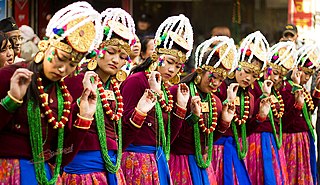
The current population of Nepal is 29,164,578 as per the 2021 census. The population growth rate is 0.92% per year.

Newar or Newari, known officially in Nepal as Nepal Bhasa, is a Sino-Tibetan language spoken by the Newar people, the indigenous inhabitants of Nepal Mandala, which consists of the Kathmandu Valley and surrounding regions in Nepal.

Gurung or Tamu are an ethnic group indigenous to the hills and mountains of Gandaki Province of Nepal. Gurung people predominantly live around the Annapurna region in Manang, Mustang, Dolpo, Kaski, Lamjung, Gorkha, Parbat,Tanahun and Syangja districts of Nepal. They are one of the main Gurkha tribes.

Newar, or Nepami, are the historical inhabitants of the Kathmandu Valley and its surrounding areas in Nepal and the creators of its historic heritage and civilisation. Newars form a linguistic and cultural community of primarily Indo-Aryan and Tibeto-Burman ethnicities following Hinduism and Buddhism with Nepal Bhasa as their common language. Newars have developed a division of labour and a sophisticated urban civilisation not seen elsewhere in the Himalayan foothills. Newars have continued their age-old traditions and practices and pride themselves as the true custodians of the religion, culture and civilisation of Nepal. Newars are known for their contributions to culture, art and literature, trade, agriculture and cuisine. Today, they consistently rank as the most economically and socially advanced community in Nepal, according to the annual Human Development Index published by UNDP. Newars are ranked the 8th largest ethnic group in Nepal according to the 2021 Nepal census numbering 1,341,363 people constituting 4.6% of the total population.

The Tamang, are a Tibeto-Burman ethnic group of Nepal, Southern Bhutan and North India. In Nepal, Tamang people constituted 5.6% of the Nepalese population at over 1.3 million in 2001, increasing to 1,539,830 as of the 2011 census. The Tamang people are concentrated in the central hilly region of Nepal. Indian Tamangs are found in significant numbers in the state of Sikkim and the districts of Darjeeling and Kalimpong in West Bengal state. Bhutanese Tamangs are native to various districts in the southern foothills of the Kingdom of Bhutan. Such districts include the Tsirang District, the Dagana District, the Samtse District, the Chukha District, the Sarpang District and the Samdrup Jongkhar District. Tamang language is the fifth most-spoken language in Nepal.
Buddhism in Nepal started spreading since the reign of Ashoka through Indian and Tibetan missionaries. The Kirati people were the first people in Nepal who embraced Gautama Buddha’s teachings, followed by the Licchavis and Newar people. Shakyamuni Buddha was born in Lumbini in the Shakya Kingdom. Besides Shakyamuni Buddha, there are many Buddha(s) before him who are worshipped in different parts of Nepal. Lumbini lies in present-day Rupandehi District, Lumbini zone of Nepal. Buddhism is the second-largest religion in Nepal. According to 2001 census, 10.74% of Nepal's population practiced Buddhism, consisting mainly of Tibeto-Burman-speaking ethnicities and the Newar. However, in the 2011 census, Buddhists made up just 9% of the country's population.

The culture of Nepal encompasses the various cultures belonging to the 125 distinct ethnic groups present in Nepal. The culture of Nepal is expressed through music and dance; art and craft; folklore; languages and literature; philosophy and religion; festivals and celebration; foods and drinks.

Kathmandu District is a district located in Kathmandu Valley, Bagmati Province of Nepal. It is one of the 77 districts of Nepal, covers an area of 413.69 km2 (159.73 sq mi), and is the most densely populated district of Nepal with 1,081,845 inhabitants in 2001, 1,744,240 in 2011 and 2,017,532 in 2021. The administrative headquarters of Kathmandu district is located in Kathmandu. The city has 21 post offices which handle mail from across the country and beyond, with Kathmandu DPO having 44,600 as its postal code for international mail delivery services like UPS or DHL Couriers etc.

Gurung, also known as Tamu Kyi or Tamu Bhāṣā, is a Sino-Tibetan language spoken by the Gurung people of Nepal. The total number of all Gurung speakers in Nepal was 227,918 in 1991 and 325,622 in 2011.
The Nepalese caste system was the traditional system of social stratification of Nepal. The Nepalese caste system broadly borrows the classical Hindu Chaturvarnashram model, consisting of four broad social classes or varna: Brahmin, Kshatriya, Vaishya, Sudra.

The Kirati people, also spelled as Kirant, are Sino-Tibetan ethnolinguistic groups and indigenous peoples of the Himalayas, mostly the Eastern Himalaya extending eastward from Nepal to Northern India (predominantly in the Indian States of Sikkim and Darjeeling & Kalimpong hills of northern West Bengal
The Dhimal or Dhemal are an Kirati ethnic group residing in the eastern Terai of Nepal. They are a Sino-Tibetan-speaking ethnic group of the eastern Terai. They mainly reside in Morang and Jhapa districts of Nepal and Darjeeling district of West Bengal, India. They are respected as the "First Citizens" of Damak municipality.

Languages of Nepal, referred to as Nepalese languages in the country's constitution, are the languages having at least an ancient history or origin inside the sovereign territory of Nepal spoken by Nepalis. The 2011 national census listed 123 languages spoken as a mother tongue in Nepal. Most belong to the Indo-Aryan and Sino-Tibetan language families.

There are two dozen languages of Bhutan, all members of the Tibeto-Burman language family except for Nepali, which is an Indo-Aryan language, and Bhutanese Sign Language. Dzongkha, the national language, is the only native language of Bhutan with a literary tradition, though Lepcha and Nepali are literary languages in other countries. Other non-Bhutanese minority languages are also spoken along Bhutan's borders and among the primarily Nepali-speaking Lhotshampa community in South and East Bhutan. Chöke is the language of the traditional literature and learning of the Buddhist monastics.

South Asia is home to several hundred languages, spanning the countries of Afghanistan, Bangladesh, Bhutan, India, Maldives, Nepal, Pakistan, and Sri Lanka. It is home to the third most spoken language in the world, Hindi–Urdu; and the sixth most spoken language, Bengali. The languages in the region mostly comprise Indo-Iranic and Dravidian languages, and further members of other language families like Austroasiatic, and Tibeto-Burman languages.
Bahun, also known as Hill Brahmins, are a Brahmin varna among the Khas of Nepal. They are Sub caste of the Kanyakubja Brahmin while their origins are from Kannauj and the Himalayan belt of South Asia. According to the 2011 Nepal census, Bahun is the second most populous group after Chhetri.

The Tibeto-Burman languages are the non-Sinitic members of the Sino-Tibetan language family, over 400 of which are spoken throughout the Southeast Asian Massif ("Zomia") as well as parts of East Asia and South Asia. Around 60 million people speak Tibeto-Burman languages. The name derives from the most widely spoken of these languages, Burmese and the Tibetic languages, which also have extensive literary traditions, dating from the 12th and 7th centuries respectively. Most of the other languages are spoken by much smaller communities, and many of them have not been described in detail.
The Pahadi people are an indigenous group of the Himalayas. Most Indo-Aryan Paharis, however, identify as members of constituent subgroups and castes within the larger Pahari community such as Brahmin, Kshatriya and Dalits.

Mugom-Karmarong is the Sino-Tibetan language variety of the Tibetan people of Mugu district in Nepal. This language variety represents two dialects Mugom and Karmarong, which are spoken by distinct ethnicities and are separate language in the perceptions of these groups. Based on census data taken in 2011, the total population of Mugom-Karmarong is estimated to be about 7,500 speakers.

Lhowa (ल्होवा), also known as Loke Tibetan, Mustang Tibetan and Lhopa is a Sino-Tibetan language spoken by approximately 3,000 Tibetan people of Mustang District in central Nepal.




















